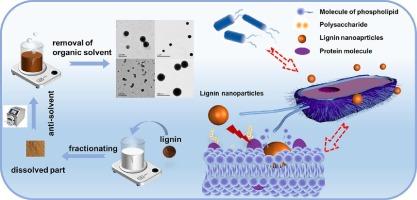International Journal of Biological Macromolecules ( IF 7.7 ) Pub Date : 2023-06-28 , DOI: 10.1016/j.ijbiomac.2023.125596 Huanli Gao 1 , Mengya Sun 1 , Yuqing Duan 1 , Yuqun Cai 1 , Hongqi Dai 1 , Tingting Xu 1

|
As a kind of polyphenol substance, lignin is considered to have good biological activity and certain antibacterial properties. However, it is difficult to be applied because of its uneven molecular weight and difficulty in separation. In this study, by way of fractionation and antisolvent, we obtained lignin fractions with different molecular weight. Moreover, we increased the content of active functional groups and regulated microstructure of lignin, thereby increased lignin's antibacterial property. The classification of chemical components and the control of particle morphology also provided convenience for the exploration of lignin's antibacterial mechanism. The results showed that acetone with high hydrogen bonding ability could collect lignin with different molecular weights and increase the content of phenolic hydroxyl groups, up to 31.2 %. By adjusting the ratio of water/solvent (v/v) and stirring rate during the process of antisolvent, lignin nanoparticles (sphere 40–300 nm) with regular shape and uniform size can be obtained. Through observing the distribution of lignin nanoparticles in vivo and in vitro after co-incubation for different time, it could be found that lignin nanoparticles firstly damage structural integrity of bacterial cells externally, and then are swallowed into cells to affect their protein synthesis, which constitutes a dynamic antibacterial process.
中文翻译:

抗菌木质素纳米粒子的可控合成及其抗菌机制分析
木质素作为一种多酚物质,被认为具有良好的生物活性和一定的抗菌性能。但由于其分子量不均、分离困难,应用困难。本研究通过分馏和反溶剂的方法,获得了不同分子量的木质素馏分。此外,我们还增加了活性官能团的含量,调控了木质素的微观结构,从而提高了木质素的抗菌性能。化学成分的分类和颗粒形态的控制也为木质素抗菌机制的探索提供了便利。结果表明,具有高氢键能力的丙酮可以捕获不同分子量的木质素,并提高酚羟基含量,最高可达31.2%。通过调节反溶剂过程中水/溶剂的比例(v /v)和搅拌速率,可以获得形状规则、尺寸均匀的木质素纳米颗粒(球体40-300 nm)。通过观察木质素纳米粒子在体内和体外共孵育不同时间后的分布情况可以发现,木质素纳米粒子首先在外部破坏细菌细胞的结构完整性,然后被吞入细胞内影响其蛋白质合成,从而构成细菌细胞的蛋白质合成。动态抗菌过程。















































 京公网安备 11010802027423号
京公网安备 11010802027423号